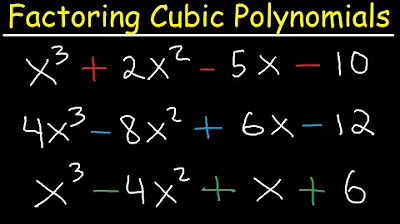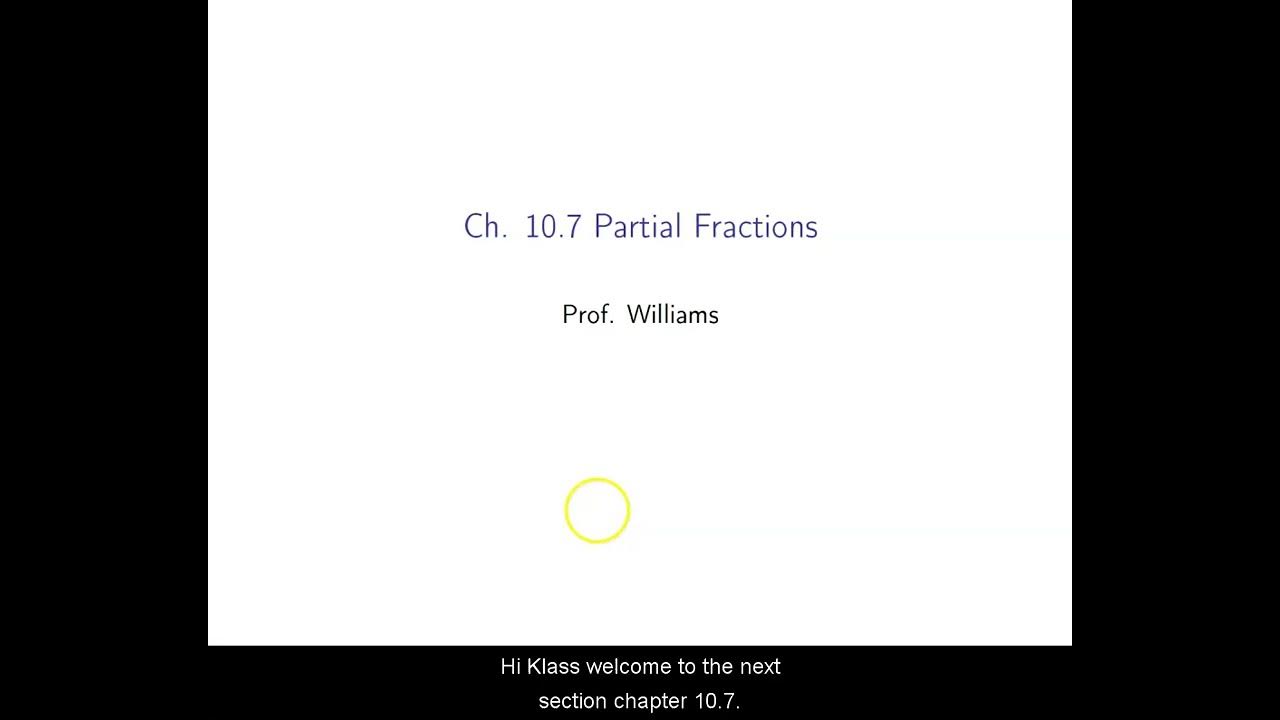Algebra II - 3.3 Factoring Polynomials
TLDRThis script delves into the concept of factoring, the inverse of multiplication, demonstrating how to break down expressions into their constituent factors. It covers the extraction of common monomial factors from polynomials, including numerical and variable factors, and discusses the verification process through multiplication. The script also introduces factoring by grouping for expressions with four terms, illustrating the technique with examples and emphasizing the importance of recognizing common factors for successful factorization.
Takeaways
- 🔍 The script discusses the concept of factoring, which is the inverse process of multiplication, aiming to break down expressions into their constituent factors.
- 📚 Factoring is demonstrated with the example of transforming a multiplied expression like 2x + 6 back into its factored form, 2(x + 3).
- 🔑 A common monomial factor is identified as a factor that is common to all terms in a polynomial, and the script shows how to extract this common factor.
- 📉 The script emphasizes the importance of checking factored forms by multiplying the factors to ensure they yield the original expression.
- 🔢 The largest common numerical factor and the common variable factors are identified in the script to simplify the factoring process for polynomials.
- 📝 The script provides a step-by-step method for factoring polynomials, including pulling out common factors and simplifying the remaining terms.
- 🔄 The process of factoring by grouping is introduced, which involves grouping terms and factoring out common factors within each group.
- 🤔 The script highlights the consideration of whether to factor out a positive or negative common factor, depending on the situation.
- 📊 The script explains how to handle binomials as single entities in factoring, similar to single letters, and how to factor expressions with two terms.
- 📌 The importance of ensuring that the factored form multiplies back to the original expression is stressed, with the inclusion of '1' where necessary to maintain the equality.
- 🔄 The script also discusses the technique of changing signs within terms to facilitate further factoring, particularly when common binomial factors are present.
Q & A
What is the process of factoring in mathematics?
-Factoring is the mathematical process that is the inverse of multiplication. It involves taking a multiplied expression and breaking it down into its constituent factors.
How does the distributive property relate to factoring?
-The distributive property is used in multiplication to express the sum of terms multiplied by a number as the sum of individual products. In factoring, we essentially reverse this process to express a sum of terms as a product of a common factor and other terms.
What is a common monomial factor?
-A common monomial factor is a term that is present in each term of a polynomial and can be factored out from all terms, simplifying the expression into a product of the common factor and the remaining terms.
How can you verify if a factored form is correct?
-To verify a factored form, you can multiply the factors together and check if the result matches the original expression before factoring.
What is the largest numerical factor in the numbers 6, 30, and 12?
-The largest numerical factor in the numbers 6, 30, and 12 is 6, as it is the greatest number that divides all three numbers without a remainder.
How do you determine the common variable factor in a polynomial?
-To determine the common variable factor, you look for the highest power of the variable that is present in all terms of the polynomial. In the script's example, the common variable factor is three factors of X, as it is the highest power of X common to all terms.
What is the significance of factoring by grouping?
-Factoring by grouping is a technique used when there is no common monomial factor across all terms of a polynomial. It involves grouping terms and factoring out the greatest common factor from each group, then looking for a common binomial factor to factor out from the resulting expression.
Why might you choose to factor out a negative common factor instead of a positive one?
-Factoring out a negative common factor can be more valuable in certain situations because it can simplify the expression or make certain patterns more apparent. It also changes the signs of the terms, which can be useful for further manipulation or simplification.
What happens when you factor out a negative common factor from a polynomial?
-When you factor out a negative common factor, the signs of all terms in the polynomial change as a result. This is because factoring out a negative is equivalent to multiplying the remaining terms by -1.
How does the concept of 'pulling out' a factor relate to the process of factoring?
-The concept of 'pulling out' a factor is a visual way to describe the process of factoring. It means identifying a common term or expression in all parts of a polynomial and extracting it to simplify the overall expression.
What role can binomials play in the factoring process?
-Binomials can act as single entities in the factoring process, especially when they are common to all terms of an expression. They can be factored out just like monomials, simplifying the expression into a product of the binomial and the remaining terms.
Outlines
📚 Understanding Factoring as the Inverse of Multiplication
This paragraph introduces the concept of factoring as the reverse process of multiplication. It explains that factoring involves breaking down a multiplied expression into its constituent factors. The common monomial factor technique is discussed, where a shared factor is extracted from each term of a polynomial, simplifying it to a product of simpler expressions. The paragraph also emphasizes the importance of checking the factored form by multiplying it out to ensure it matches the original expression. Examples are given to illustrate the process, including factoring out numerical and variable factors, and the significance of choosing the largest common factor is highlighted.
🔍 Factoring Techniques: Common Monomial Factors and Grouping
This paragraph delves into different factoring techniques, starting with the common monomial factor method applied to polynomials with more complex terms. It demonstrates how to identify the largest numerical and variable factors and how to extract them to simplify the expression. The concept of factoring by grouping is introduced for expressions with four terms, where terms are grouped and common factors within each group are extracted before factoring out a common binomial factor. The paragraph also discusses the impact of factoring out negative numbers, which results in a sign change for each term in the factored form. Examples are provided to clarify the process, including the strategic manipulation of signs to facilitate further factoring.
Mindmap
Keywords
💡Factoring
💡Common Monomial Factor
💡Distributive Property
💡Polynomial
💡Verification
💡Largest Common Factor
💡Factoring by Grouping
💡Binomial
💡Sign Change
💡Variable
Highlights
Introduction to the concept of factoring as the inverse process of multiplication.
Explanation of using the distributive property in reverse for factoring expressions.
Demonstration of factoring by taking out a common monomial factor from terms.
Illustration of how to factor 2x + 6 by identifying common factors.
The importance of checking factored forms by multiplying them out to verify correctness.
Method of identifying the largest common numerical factor in a polynomial.
Technique for factoring by pulling out the greatest common factor of variables.
Example of factoring a polynomial with multiple terms by extracting common factors.
Discussion on the difference between factoring with a positive and a negative common factor.
Explanation of sign changes when factoring with a negative common factor.
Introduction to the concept of binomials acting as single letters in factoring.
Process of factoring by grouping for expressions with four terms.
Technique of grouping terms to find common factors and factor by grouping.
The role of the number one in ensuring the multiplication of factored forms is correct.
Strategy for forcing factorization by changing signs to match common binomial factors.
Final example demonstrating the complete factoring by grouping process.
Emphasis on the importance of verifying factored forms for accuracy.
Transcripts
5.0 / 5 (0 votes)
Thanks for rating:





